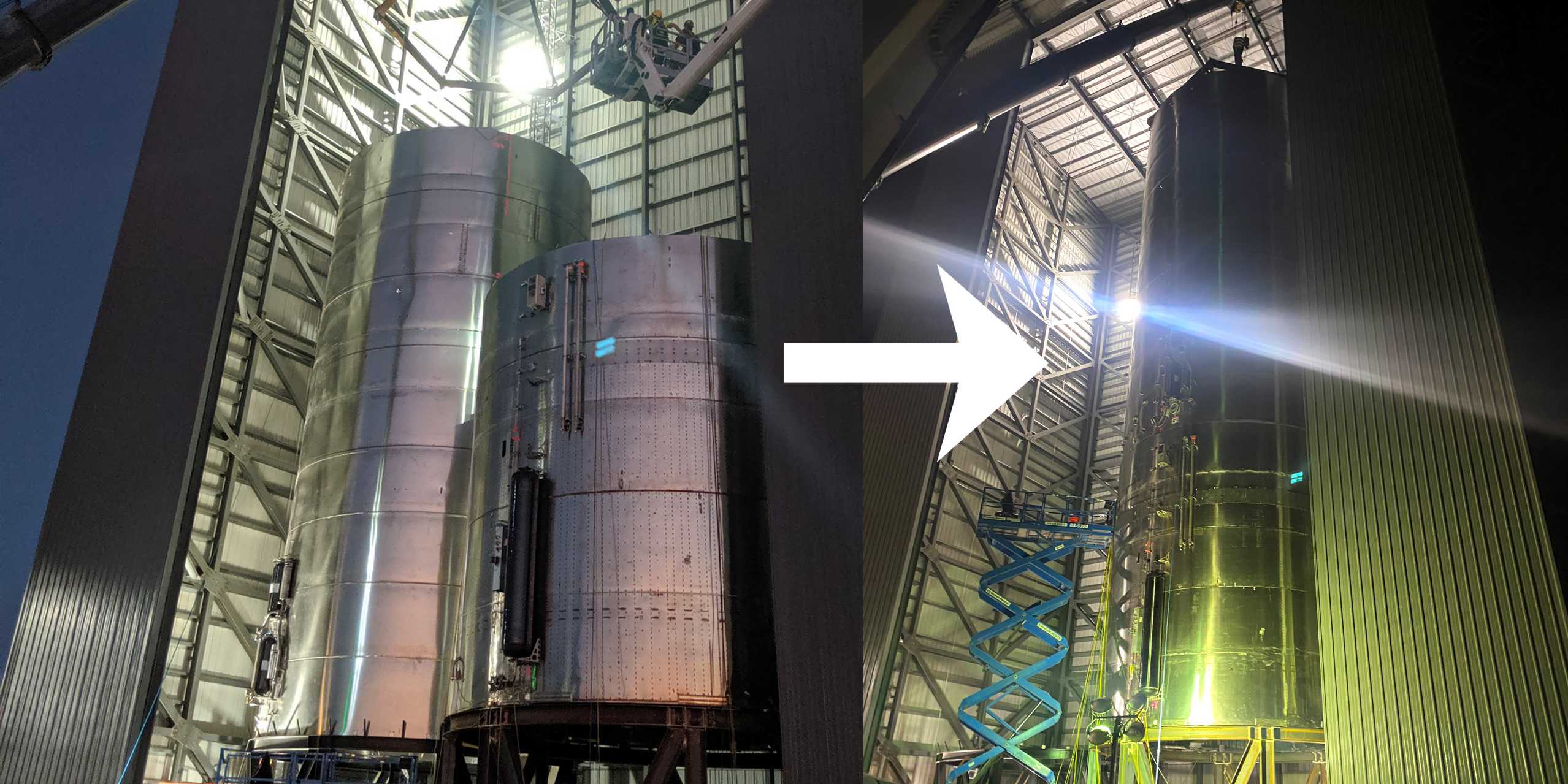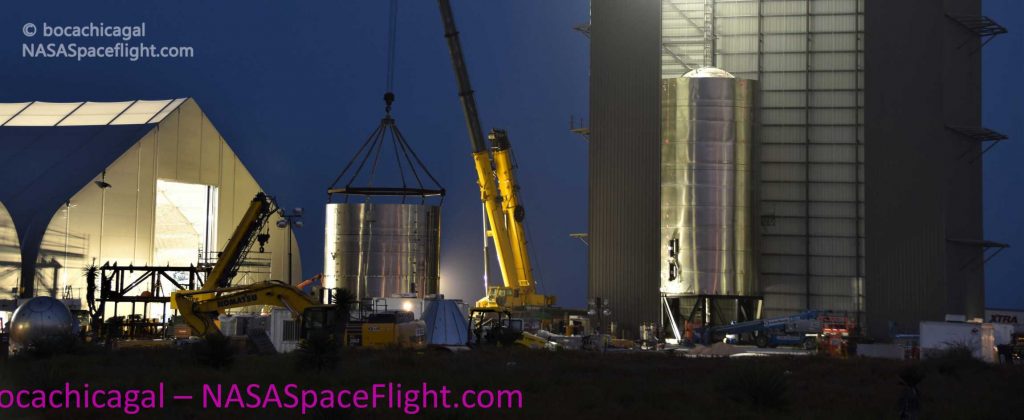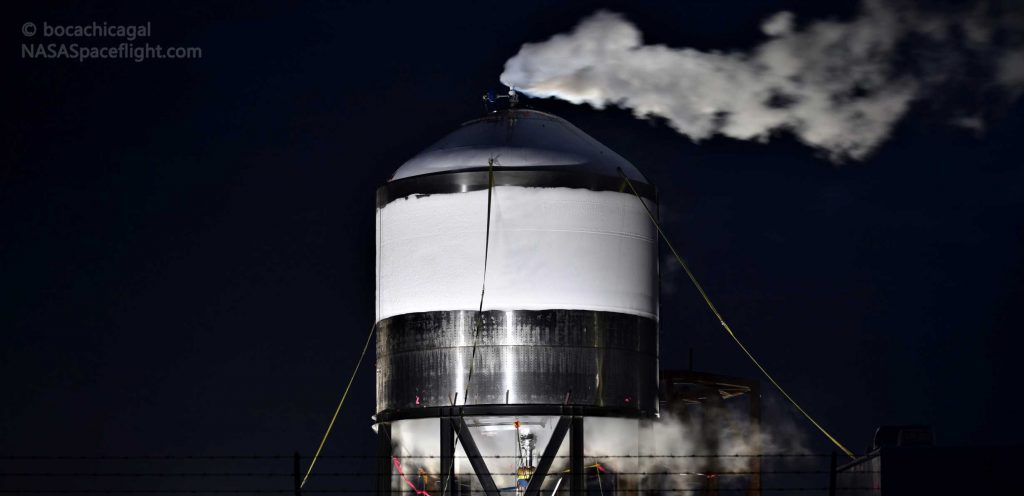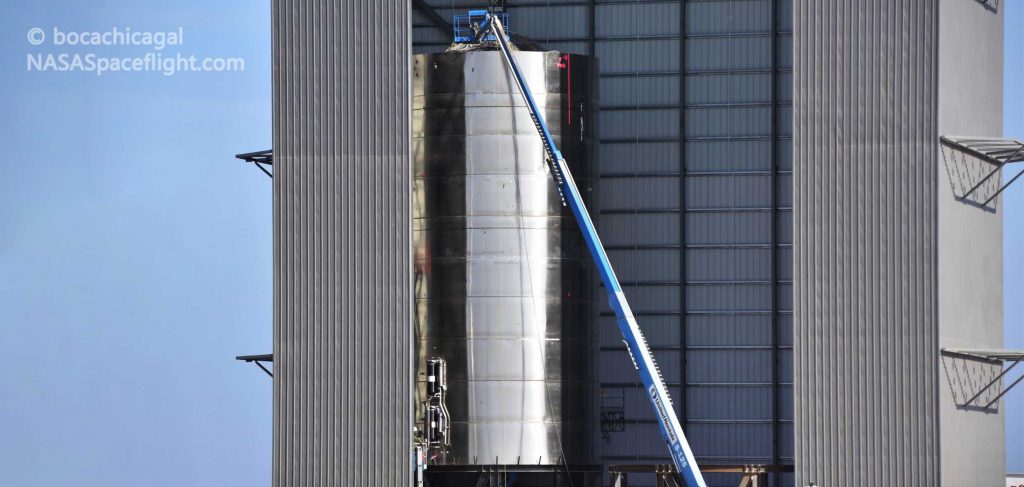

News
SpaceX Starship launch pad upgraded as Elon Musk reveals rocket production milestone
SpaceX has begun to upgrade its South Texas Starship launch pad in anticipation of the completion of the next full-scale rocket prototype, photos of which CEO Elon Musk revealed just hours ago.
Working in parallel with efforts to repair damage caused by Starship serial number 1’s (SN1) violent February 28th test failure, SpaceX has managed to build, complete, and test an entirely separate ‘test tank’ and complete fabrication of a second full-scale Starship in a handful of weeks. Flexing the growing capabilities of the impressive Boca Chica, Texas Starship factory SpaceX has sprung up in just three months, the company is working around the clock to build not just one – but several – Starship prototypes simultaneously.
A successful March 9th tank test designed to prove a new thrust structure design managed to do just that less than two weeks after the same faulty part brought about Starship SN1’s demise. In the two weeks since that its test completion, SpaceX has been busy welding, stacking, welding, and stacking several separate sections of the next Starship prototype, known as SN3. Potentially a matter of days away from structural completion, focus has recently shifted to the launch pad the ship will be tested at. In the last few days, SpaceX technicians have begun to install a bizarre, new structural element on the mount Starship SN3 will be secured on top of, hinting at the goals of the rocket’s first test campaign.

Squeezing in alongside efforts to repair the propellant lines that run into the launch mount, upgrades began on March 24th as a SpaceX team worked to install what looked like an incredibly sturdy tripod (with four ‘legs’, of course). Thanks to familiar testing done with SpaceX’s most recent Starship tank prototype, the purpose of the launch mount’s newest appendage quickly became clear.


During the Starship SN2 tank’s thrust structure (‘thrust puck’, per Elon Musk) test campaign, SpaceX debuted the concurrent use of a beefy hydraulic jack to simulate the forces a Raptor engine static might produce. Capable of producing upwards of 200 metric tons (440,000 lbf) of thrust at full power, SpaceX will likely begin Starship static fire tests with a single Raptor engine. As soon as a Starship prototype completes one or several single-engine test fires, the plan is to install three sea level-optimized Raptor engines and repeat static fire tests.
Before that triple-engine static fire milestone, a first for the cutting-edge Raptor engine, SpaceX needs to verify that Starship’s thrust structure can stand up to the ~600 tons (~1.3M lbf) of force it will be subjected to during such a test. Sitting on a much smaller stand, Starship SN2 used a single hydraulic jack and temporary stand to simulate a single engine’s thrust. Starship SN3, sitting much higher above the ground, will need three jacks to simulate three Raptors.

As such, it looks likely that Starship SN3’s first cryogenic tank proof test – filling the vehicle with inert liquid nitrogen – will coincide with a second dedicated stress test of a Starship thrust structure, hopefully proving itself capable of surviving the force of three Raptor engines at full thrust. While orbital-class Starships will need three more vacuum-optimized Raptor engines, three sea-level engines are all SpaceX needs to begin flight tests with suborbital prototypes.
Based on an unofficial analysis of existing photos, it appears that every single major structural piece of Starship SN3 – excluding legs and fins – is nearing completion, even including the ship’s shiny nosecone. Likely to head to the launch pad for its first tests as soon as the tank section alone has been completed, just one stacking event remains before said tank section reaches its full height. Right now, both of those parts have been moved to a dedicated Vehicle/Vertical Assembly Building (VAB) and are probably no more than a day or two away from being joined*. Perhaps just a day or two after that milestone, SpaceX will likely transport the massive rocket to the launch pad to begin preparing for its first proof tests.
*Around 3am local time, SpaceX technicians stacked Starship SN3’s two main segments, completing its tank and engine section.
Elon Musk
Tesla investors will be shocked by Jim Cramer’s latest assessment
Jim Cramer is now speaking positively about Tesla, especially in terms of its Robotaxi performance and its perception as a company.

Tesla investors will be shocked by analyst Jim Cramer’s latest assessment of the company.
When it comes to Tesla analysts, many of them are consistent. The bulls usually stay the bulls, and the bears usually stay the bears. The notable analysts on each side are Dan Ives and Adam Jonas for the bulls, and Gordon Johnson for the bears.
Jim Cramer is one analyst who does not necessarily fit this mold. Cramer, who hosts CNBC’s Mad Money, has switched his opinion on Tesla stock (NASDAQ: TSLA) many times.
He has been bullish, like he was when he said the stock was a “sleeping giant” two years ago, and he has been bearish, like he was when he said there was “nothing magnificent” about the company just a few months ago.
Now, he is back to being a bull.
Cramer’s comments were related to two key points: how NVIDIA CEO Jensen Huang describes Tesla after working closely with the Company through their transactions, and how it is not a car company, as well as the recent launch of the Robotaxi fleet.
Jensen Huang’s Tesla Narrative
Cramer says that the narrative on quarterly and annual deliveries is overblown, and those who continue to worry about Tesla’s performance on that metric are misled.
“It’s not a car company,” he said.
He went on to say that people like Huang speak highly of Tesla, and that should be enough to deter any true skepticism:
“I believe what Musk says cause Musk is working with Jensen and Jensen’s telling me what’s happening on the other side is pretty amazing.”
Tesla self-driving development gets huge compliment from NVIDIA CEO
Robotaxi Launch
Many media outlets are being extremely negative regarding the early rollout of Tesla’s Robotaxi platform in Austin, Texas.
There have been a handful of small issues, but nothing significant. Cramer says that humans make mistakes in vehicles too, yet, when Tesla’s test phase of the Robotaxi does it, it’s front page news and needs to be magnified.
He said:
“Look, I mean, drivers make mistakes all the time. Why should we hold Tesla to a standard where there can be no mistakes?”
It’s refreshing to hear Cramer speak logically about the Robotaxi fleet, as Tesla has taken every measure to ensure there are no mishaps. There are safety monitors in the passenger seat, and the area of travel is limited, confined to a small number of people.
Tesla is still improving and hopes to remove teleoperators and safety monitors slowly, as CEO Elon Musk said more freedom could be granted within one or two months.
News
Tesla launches ultra-fast V4 Superchargers in China for the first time
Tesla has V4 Superchargers rolling out in China for the first time.

Tesla already has nearly 12,000 Supercharger piles across mainland China. However, the company just initiated the rollout of the ultra-fast V4 Superchargers in China for the first time, bringing its quick-charging piles to the country for the first time since their launch last year.
The first batch of V4 Superchargers is now officially up and running in China, the company announced in a post on Chinese social media outlet Weibo today.
The company said in the post:
“The first batch of Tesla V4 Superchargers are online. Covering more service areas, high-speed charging is more convenient, and six-layer powerful protection such as rain and waterproof makes charging very safe. Simultaneously open to non-Tesla vehicles, and other brands of vehicles can also be charged. There are more than 70,000 Tesla Superchargers worldwide. The charging network layout covers 100% of the provincial capitals and municipalities in mainland China. More V4 Superchargers will be put into use across the country. Optimize the charging experience and improve energy replenishment efficiency. Tesla will accompany you to the mountains, rivers, lakes, and seas with pure electricity!”
The first V4 Superchargers Tesla installed in China are available in four cities across the country: Shanghai, Zhejiang, Gansu, and Chongqing.

Credit: Tesla China
Tesla has over 70,000 Superchargers worldwide. It is the most expansive and robust EV charging network in the world. It’s the main reason why so many companies have chosen to adopt Tesla’s charging connector in North America and Europe.
In China, some EVs can use Tesla Superchargers as well.
The V4 Supercharger is capable of charging vehicles at speeds of up to 325kW for vehicles in North America. This equates to over 1,000 miles per hour of charging.
Elon Musk
Elon Musk hints at when Tesla could reduce Safety Monitors from Robotaxi
Tesla could be reducing Safety Monitors from Robotaxi within ‘a month or two,’ CEO Elon Musk says.

Elon Musk hinted at when Tesla could begin reducing Safety Monitors from its Robotaxis. Safety Monitors are Tesla employees who sit in the front passenger seat during the driverless rides, and are there to ensure safety for occupants during the earliest rides.
Tesla launched its Robotaxi fleet in Austin last Sunday, and after eight days, videos and reviews from those who have ridden in the driverless vehicles have shown that the suite is safe, accurate, and well coordinated. However, there have been a few hiccups, but nothing that has put anyone’s safety in danger.
A vast majority — close to all of the rides — at least according to those who have ridden in the Robotaxi, have been performed without any real need for human intervention. We reported on what was the first intervention last week, as a Safety Monitor had to step in and stop the vehicle in a strange interaction with a UPS truck.
Watch the first true Tesla Robotaxi intervention by safety monitor
The Tesla and UPS delivery truck were going for the same street parking space, and the Tesla began to turn into it. The UPS driver parallel parked into the spot, which was much smaller than his truck. It seemed to be more of an instance of human error instead of the Robotaxi making the wrong move. This is something that the driverless cars will have to deal with because humans are aggressive and sometimes make moves they should not.
The Safety Monitors have not been too active in the vehicles. After all, we’ve only seen that single instance of an intervention. There was also an issue with the sun, when the Tesla braked abnormally due to the glare, but this was an instance where the car handled the scenario and proceeded normally.
With the Robotaxi fleet operating impressively, some are wondering when Tesla will begin scaling back both the Safety Monitors and Teleoperators that it is using to ensure safety with these early rides.
CEO Elon Musk answered the inquiry by stating, “As soon as we feel it is safe to do so. Probably within a month or two.”
As soon as we feel it is safe to do so.
Probably within a month or two. We continue to improve the Tesla AI with each mile driven.
— Elon Musk (@elonmusk) June 30, 2025
Musk’s response seems to confirm that there will be fewer Teleoperators and Safety Monitors in the coming months, but there will still be some within the fleet to ensure safety. Eventually, that number will get to zero.
Reaching a point where Tesla’s Robotaxi is driverless will be another significant milestone for the company and its path to fully autonomous ride-sharing.
Eventually, Tesla will roll out these capabilities to consumer-owned vehicles, offering them a path to generate revenue as their car operates autonomously and completes rides.
For now, Tesla is focusing on perfecting the area of Austin where it is currently offering driverless rides for just $4.20 to a small group of people.
-

 News5 days ago
News5 days agoTesla Robotaxi’s biggest challenge seems to be this one thing
-

 News2 weeks ago
News2 weeks agoTesla confirms massive hardware change for autonomy improvement
-

 Elon Musk2 weeks ago
Elon Musk2 weeks agoElon Musk slams Bloomberg’s shocking xAI cash burn claims
-

 News2 weeks ago
News2 weeks agoTesla China roars back with highest vehicle registrations this Q2 so far
-

 News2 weeks ago
News2 weeks agoTesla features used to flunk 16-year-old’s driver license test
-

 News2 weeks ago
News2 weeks agoTexas lawmakers urge Tesla to delay Austin robotaxi launch to September
-

 News2 weeks ago
News2 weeks agoTesla dominates Cars.com’s Made in America Index with clean sweep
-

 News2 weeks ago
News2 weeks agoTesla’s Grok integration will be more realistic with this cool feature





















